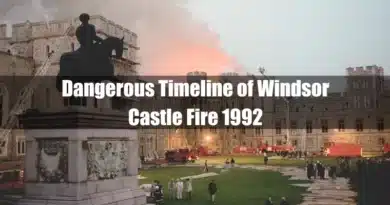Choosing a single “best bit” of Windsor Castle is nearly impossible. From the awe-inspiring Gothic splendour of St. George’s Chapel to the opulent State Apartments dripping with gold leaf, each area offers a unique glimpse into history and royalty. For an exceptional experience, don’t miss Queen Mary’s Dolls’ House, a miniature masterpiece showcasing Edwardian life in intricate detail, or the Changing of the Guard ceremony, a vibrant display of British tradition.
Queen Mary’s Dolls’ House stands out if pressed to choose a single “best bit” of Windsor Castle. This miniature masterpiece transcends being just a dollhouse. It’s a meticulously crafted time capsule, offering a glimpse into the intricacies of Edwardian life. It’s a marvel of engineering and artistry, from fully-stocked miniature shops with tiny groceries to working electricity and a functioning elevator. This level of detail and dedication to portraying a bygone era makes it a truly unique treasure within the castle walls.
I. Introduction: A Legacy Forged Through Time

A. A Brief History of Windsor Castle: From William the Conqueror to the Present Day
Windsor Castle boasts a rich and fascinating history stretching back nearly a millennium. Its story begins in the aftermath of the Norman Conquest of 1066. In seeking to solidify his control over England, William the Conqueror recognized the strategic importance of a high ground overlooking the River Thames. Around 1070, he ordered the construction of a motte-and-bailey castle – a fortified mound surrounded by a wooden enclosure – laying the foundation for what we see today.
Over the centuries, successive monarchs have continuously added to and reshaped the castle. In the 12th century, Henry II replaced the wooden structures with a formidable stone castle, including the iconic Round Tower that still stands guard. In the 13th century, Henry III strengthened the defences and built the first royal chapel on the site.
In the 14th century, Edward III transformed the castle from a military stronghold into a luxurious palace fit for a king. He spent lavishly constructing the Upper Ward with its grand apartments, which continue to be used by the British Royal Family today. Subsequent monarchs like Charles II and George IV have also left their mark, adding their personal touches and architectural flourishes.
B. Why Windsor Castle? Exploring the Significance and Allure
Windsor Castle holds a unique position in British history. Unlike many castles that fell into disuse or ruin, the monarchy has continuously occupied Windsor for over 900 years. This enduring presence makes it the longest-occupied palace in Europe, a testament to its strategic location and enduring allure.
The castle’s significance goes beyond its longevity. It has served as a royal residence, a government centre, and a national identity symbol. Kings and queens have held court, planned wars, and celebrated victories within its walls. Its grandeur and architectural diversity reflect the evolution of British taste and power through the ages.
Today, Windsor Castle remains a working royal palace. The Queen spends a significant amount of time here, using it for both official and private functions. It is also a popular tourist destination, attracting visitors from around the world who come to marvel at its architectural beauty, historical significance, and ongoing role in British life.
II. The Architectural Splendor: A Journey Through Time and Grandeur
A. St George’s Chapel: A Gothic Masterpiece and Royal Burial Ground

A crown jewel of Windsor Castle, St George’s Chapel is a breathtaking example of Perpendicular Gothic architecture. Construction began in the 14th century under Edward IV and was completed by his successors. The soaring ceilings, intricate fan vaulting, and expansive stained-glass windows create an atmosphere of awe and reverence.
St George’s Chapel is not just an architectural gem; it’s also a significant religious and historical site. Dedicated to England’s patron saint, St. George, it is the spiritual home of the Order of the Garter, the highest order of chivalry in the United Kingdom. Ten monarchs – including Henry VIII and Charles I – are buried within the chapel, adding to its historical weight.
B. The State Apartments: A Glimpse into Royal Life Through Opulent Rooms

No visit to Windsor Castle is complete without exploring the State Apartments. These magnificent rooms, primarily in the Upper Ward, showcase royal life and artistic achievement. They are used for official ceremonies, state visits, and royal receptions.
C. Grand Reception Room: Dazzling with Gold and Majesty
The Grand Reception Room, also known as the Throne Room, embodies the grandeur of the British monarchy. Gilded walls, ornate ceilings, and glittering chandeliers contribute to its awe-inspiring atmosphere. The room is adorned with priceless works of art, including paintings by Rubens and Van Dyck, further reflecting the refined tastes of its royal residents.
D. Crimson Drawing Room: Rich Fabrics and Exquisite Detail
In stark contrast to the grandeur of the Grand Reception Room, the Crimson Drawing Room offers a more intimate glimpse into royal life. The walls are hung with rich crimson silk, and the furniture is crafted from exquisite rosewood. The room is filled with personal treasures and portraits, creating a sense of warmth and history.
E. Waterloo Chamber: Commemorating Victory with Artistic Grandeur
The Waterloo Chamber serves as a testament to British military prowess. Commissioned by George IV to commemorate his father’s victory at the Battle of Waterloo, the room is adorned with portraits of military heroes and depictions of the battle itself. The opulent decorations and lavish furnishings reflect the celebratory nature of the space.
F. The Changing of the Guard Ceremony: A Time-Honored Tradition

One of the most popular attractions at Windsor Castle is the Changing of the Guard ceremony. This colourful spectacle, performed by the Queen’s Foot Guards, regularly occurs on the castle grounds. The changing of the guard symbolizes the ongoing responsibility of protecting the monarch. The ceremony is a vibrant display of British military tradition, with marching bands and impeccably dressed soldiers.
III. Beyond the Grand Halls: Unveiling Hidden Gems

While the State Apartments and St. George’s Chapel deservedly capture the spotlight, Windsor Castle offers many experiences beyond these grand spaces.
Here are some hidden gems waiting to be explored:
- Queen Mary’s Dolls’ House: This miniature masterpiece, built between 1921 and 1924, is a national treasure. A labour of love by leading artists and craftspeople, it meticulously recreates an Edwardian aristocratic home in intricate detail. The dolls’ house offers a fascinating glimpse into a bygone era, from fully-stocked miniature shops to a working elevator.
- The Precincts Tour: Venture beyond the castle walls and explore the historic precincts surrounding it. This guided tour takes visitors past the Horseshoe Cloister, the site of the former Deanery, and the Hundred Houses, a row of timber-framed houses dating back to the 16th century. It’s a chance to discover the “working side” of the castle and gain a deeper understanding of its daily life.
- The Moat Room: Located beneath the State Apartments, the Moat Room houses a fascinating collection of detailed models and paintings depicting the castle’s evolution throughout history. These models allow visitors to visualize the castle’s changing form over the centuries, showcasing its architectural journey.
- The Long Walk and Windsor Great Park: Escape the castle walls and find tranquillity in the sprawling expanse of Windsor Great Park. Stroll along the Long Walk, a three-mile avenue lined with ancient oak trees, or explore the park’s woodlands and gardens. This vast green space offers a welcome change of pace and stunning natural beauty.
IV. Treasures and Collections: A Journey Through Artistic Splendor

Windsor Castle is not just a magnificent architectural marvel; it’s also a treasure trove of art and historical artefacts. Here’s a glimpse into some of the collections that await art enthusiasts and history buffs:
A. A Haven for Art Lovers: Paintings by Van Dyck, Holbein, and Rubens
Art lovers will be awestruck by the extensive collection of paintings housed within Windsor Castle. These works, spanning centuries and artistic movements, offer a fascinating glimpse into European artistic heritage. Among the highlights are masterpieces by renowned painters like:
- Anthony van Dyck: This Flemish master was a court painter to Charles I and Charles II. His portraits of British royalty, including Charles I on horseback, are celebrated for their elegance and psychological depth.
- Hans Holbein the Younger: This German artist served as court painter to Henry VIII. His iconic portraits of the king and his wives, including Anne Boleyn, are renowned for their realism and historical significance.
- Peter Paul Rubens: This Flemish Baroque painter’s vibrant and dynamic works, such as “The Judgement of Paris,” add a touch of grandeur to the collection.
These are just a few examples; the Royal Collection at Windsor Castle boasts an extensive array of paintings by European masters, offering a captivating journey through artistic history.
B. The China Museum: Delicate Porcelain Fit for Royalty
Windsor Castle houses a world-renowned collection of Chinese porcelain housed in the aptly named China Museum. Comprising over 4,000 pieces, the collection spans centuries and showcases the evolution of Chinese ceramic artistry. From delicate Ming Dynasty porcelain to intricately decorated Qing Dynasty pieces, the collection offers a glimpse into the artistic traditions and cultural exchange between Europe and Asia.
C. Exploring the Castle’s Furniture, Sculptures, and Other Exquisite Objects
Beyond paintings and porcelain, Windsor Castle boasts an impressive collection of furniture, sculptures, and other decorative objects. Visitors can admire exquisite French and English furniture, from ornately carved chairs to opulent tapestries. Sculptures by renowned artists like Antonio Canova and busts of Roman emperors add a touch of classical elegance to the castle’s interior. This diverse collection reflects the refined tastes of its royal residents and offers a deeper understanding of the artistic and cultural influences that shaped the castle over time.
V. Lesser-Known Gems Unveiling Hidden Corners and Stories

Windsor Castle’s grandeur and history extend beyond the main attractions. For those seeking to venture off the beaten path, here are some lesser-known gems waiting to be discovered:
- The Albert Memorial Chapel: Tucked away within the walls, this beautiful Gothic Revival chapel was built by Queen Victoria in memory of her beloved husband, Prince Albert. The chapel is adorned with mosaics and stained glass, offering a serene space for quiet reflection.
- The Norman Tower: This unassuming tower holds historical significance within the Upper Ward. Dating back to the reign of William the Conqueror, it was the original keep of the castle and offers a glimpse into its earliest phase.
- The State Apartments Ceiling Paintings: While exploring the opulent State Apartments, take a moment to appreciate the magnificent ceiling paintings. These works by renowned artists like Antonio Verrio and Louis Laguerre depict mythological and allegorical scenes, adding another layer of artistic detail to the grand rooms.
- The Queen’s Kitchen: For a glimpse into the “behind the scenes” of royal life, delve into the history of the Queen’s Kitchen. Though no longer operational, the well-preserved kitchen sheds light on the immense task of preparing meals for the royal household.
- The Garter Tower: This imposing tower within the Lower Ward was once a crucial part of the castle’s defence system. Today, it houses the archives of the Order of the Garter, offering a glimpse into Britain’s oldest and highest order of chivalry history.
Exploring these lesser-known gems allows visitors to appreciate the rich tapestry of Windsor Castle’s history. Each corner whispers a story, waiting to be unravelled by those who seek to delve deeper. So, watch for these hidden treasures on your next visit and discover a new side to this magnificent castle.
VI. Experiencing Windsor Castle: Your Guide to a Memorable Visit

A. Tips for Planning Your Visit: Tickets, Tours, and Opening Times
To ensure a smooth and enjoyable visit to Windsor Castle, some pre-planning is recommended:
- Tickets: Windsor Castle is a popular tourist destination, so purchasing tickets online in advance is highly recommended. This allows you to choose your preferred time slot and avoid long queues. Tickets can be purchased through the Royal Collection Trust website: https://tickets.rct.uk/basket.
- Tours: Guided tours by the Royal Collection Trust offer a deeper understanding of the castle’s history and treasures. Several tour options are available, catering to different interests and time constraints.
- Opening Times: Opening hours for Windsor Castle can vary depending on the season and the day of the week. It’s crucial to check the official website https://www.rct.uk/ for the most up-to-date information before your visit. Generally, the castle is closed on Tuesdays and Wednesdays, and St. George’s Chapel is closed on Sundays.
B. Special Events and Exhibitions: Adding Depth to Your Experience
Windsor Castle occasionally hosts special events and exhibitions throughout the year. These events can range from historical reenactments to in-depth displays focusing on specific aspects of the castle’s collection. Checking the Royal Collection Trust website for upcoming events can significantly enhance your visit.
C. A Memorable Day Out: Exploring the Grounds, Shops, and Restaurants
A visit to Windsor Castle isn’t just about exploring the opulent interiors. Make sure to dedicate time to wander the expansive grounds:
- The Long Walk and Windsor Great Park: These sprawling green spaces offer a welcome respite from the castle’s grandeur. Stroll along the Long Walk or explore the park’s scenic trails.
- The Shops: The castle grounds house several official souvenir shops where you can find various memorabilia, from postcards and books to traditional British gifts.
- Restaurants: Several cafes and restaurants within the castle grounds cater to various tastes and budgets. Enjoy a light lunch or afternoon tea in a historic setting.
You can ensure a memorable day at Windsor Castle by planning your visit, exploring the diverse offerings, and venturing beyond the castle walls.
VII. Conclusion to The Best Bits of Windsor Castle
A. The Enduring Legacy of Windsor Castle: A Symbol of History and Monarchy
Windsor Castle is a testament to the enduring legacy of British history and monarchy. Its transformation from a medieval fortress to a luxurious palace reflects the evolution of the British crown. For over 900 years, it has witnessed pivotal historical moments, a stage for coronations, royal weddings, and political events.
Beyond its historical significance, Windsor Castle remains a vibrant and active royal residence. The Queen spends a significant amount of time here, using it for both official and private functions. The ongoing presence of the royal family ensures the castle’s continued relevance and adds to its allure.
B. Beyond the Best: Exploring Other Fascinating Aspects of the Castle
This article has highlighted some of the “best bits” of Windsor Castle, but there’s always more to discover. Here are a few additional aspects that warrant exploration:
- The Changing of the Guard Ceremony: While mentioned earlier, it deserves another mention. Witnessing this vibrant display of military tradition is a quintessentially British experience.
- The Changing Exhibitions: The Royal Collection Trust regularly hosts temporary exhibitions showcasing themes related to the castle’s collection or British history. These exhibitions offer fresh perspectives and insights into the castle’s significance.
- The Castle Gardens: Beyond the sprawling parkland, the castle boasts a beautiful garden. Explore the meticulously maintained East Terrace Garden or the more secluded Moat Garden, which offers a peaceful oasis within the castle walls.
Unveiling the full story of Windsor Castle requires delving deeper into its rich tapestry. By exploring its architecture, art collections, historical significance, and ongoing role in British life, visitors can gain a deeper appreciation for this enduring symbol of history and monarchy.










Comments are closed.